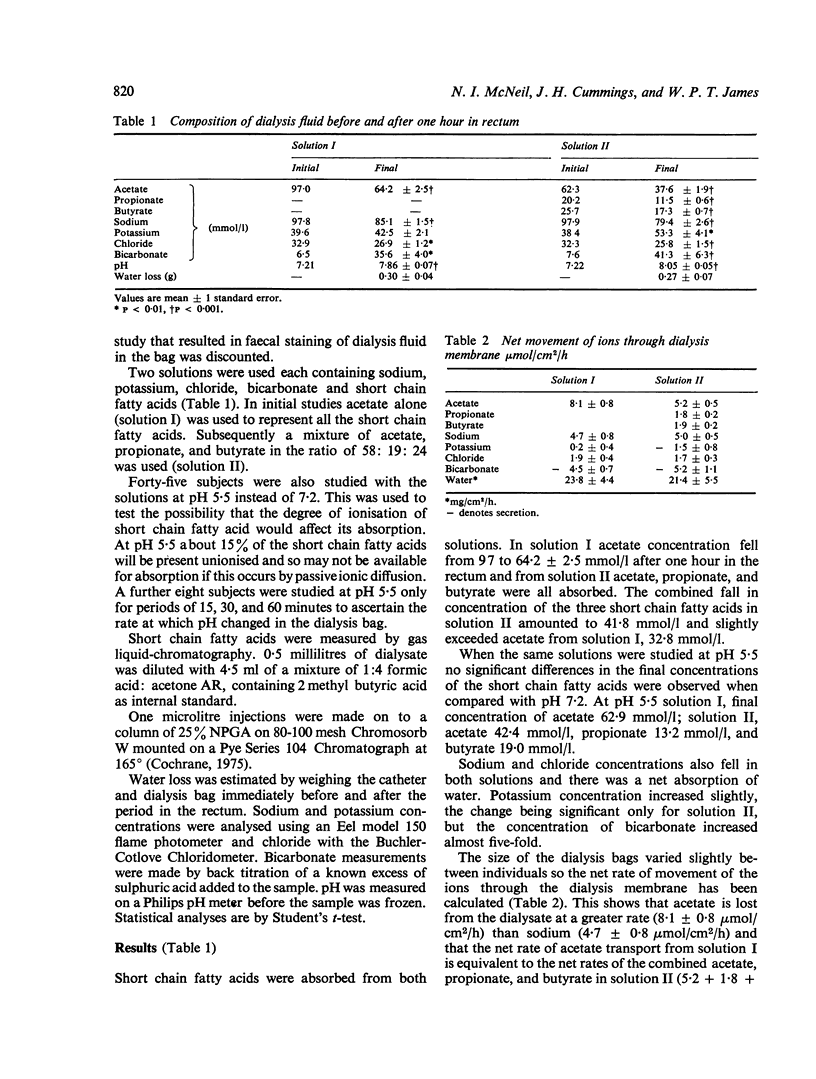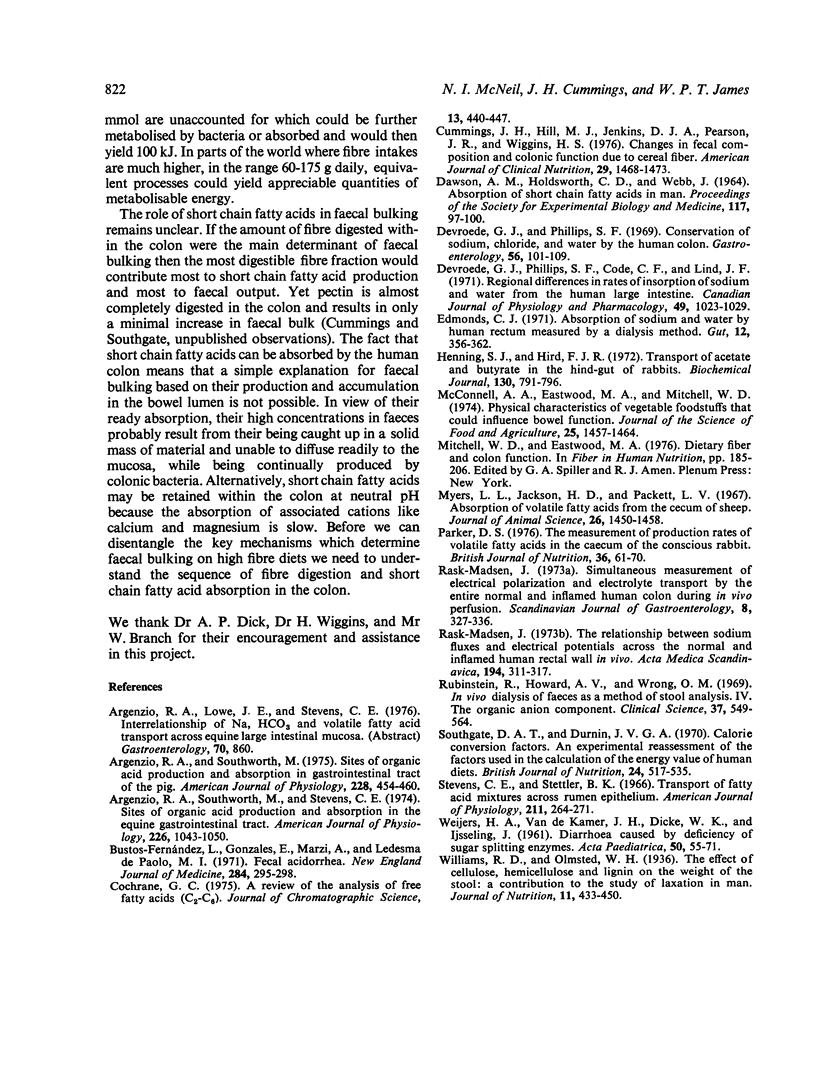Abstract
Short chain fatty acid absorption from the human rectum has been studied in 46 subjects attending an obesity clinic, using a dialysis bag technique. From a mixed electrolyte solution, acetate concentrations fell from 97.0 to 64.2 mmol/l, and sodium from 97.8 to 85.1 mmol/l with respective net absorption rates of 8.1 and 5.2 mumol/cm2/h. From a solution with mixed short chain fatty acids acetate concentration fell from 62.3 to 37.6 mmol/l, propionate from 20.2 to 11.5 mmol/l, and butyrate from 25.7 to 17.3 mmol/l with absorption rates of 5.2, 1.8, and 1.9 mumol/cm2/h. Lowering pH from 7.2 to 5.5, to test the possibility that absorption occurred by passive non-ionic diffusion, had no effect on absorption rates, although pH rose rapidly in the dialysis fluid. These results are comparable with rates of acetate absorption from the animal large intestine. The hypothesis that short chain fatty acids are not absorbed from the large gut and therefore contribute to faecal bulk by retaining water in the bowel lumen may need revision.
Full text
PDF



Selected References
These references are in PubMed. This may not be the complete list of references from this article.
- Argenzio R. A., Southworth M. Sites of organic acid production and absorption in gastrointestinal tract of the pig. Am J Physiol. 1975 Feb;228(2):454–460. doi: 10.1152/ajplegacy.1975.228.2.454. [DOI] [PubMed] [Google Scholar]
- Argenzio R. A., Southworth M., Stevens C. E. Sites of organic acid production and absorption in the equine gastrointestinal tract. Am J Physiol. 1974 May;226(5):1043–1050. doi: 10.1152/ajplegacy.1974.226.5.1043. [DOI] [PubMed] [Google Scholar]
- Bustos Fernández L., Gonzalez E., Marzi A., Ledesma de Paolo M. I. Fecal acidorrhea. N Engl J Med. 1971 Feb 11;284(6):295–298. doi: 10.1056/NEJM197102112840603. [DOI] [PubMed] [Google Scholar]
- Cochran G. C. A review of the analysis of free fatty acids [C2-C6]. J Chromatogr Sci. 1975 Sep;13(9):440–447. doi: 10.1093/chromsci/13.9.440. [DOI] [PubMed] [Google Scholar]
- Cummings J. H., Hill M. J., Jenkins D. J., Pearson J. R., Wiggins H. S. Changes in fecal composition and colonic function due to cereal fiber. Am J Clin Nutr. 1976 Dec;29(12):1468–1473. doi: 10.1093/ajcn/29.12.1468. [DOI] [PubMed] [Google Scholar]
- DAWSON A. M., HOLDSWORTH C. D., WEBB J. ABSORPTION OF SHORT CHAIN FATTY ACIDS IN MAN. Proc Soc Exp Biol Med. 1964 Oct;117:97–100. doi: 10.3181/00379727-117-29505. [DOI] [PubMed] [Google Scholar]
- Devroede G. J., Phillips S. F., Code C. F., Lind J. F. Regional differences in rates of insorption of sodium and water from the human large intestine. Can J Physiol Pharmacol. 1971 Dec;49(12):1023–1029. doi: 10.1139/y71-145. [DOI] [PubMed] [Google Scholar]
- Devroede G. J., Phillips S. F. Conservation of sodium, chloride, and water by the human colon. Gastroenterology. 1969 Jan;56(1):101–109. [PubMed] [Google Scholar]
- Edmonds C. J. Absorption of sodium and water by human rectum measured by a dialysis method. Gut. 1971 May;12(5):356–362. doi: 10.1136/gut.12.5.356. [DOI] [PMC free article] [PubMed] [Google Scholar]
- Henning S. J., Hird F. J. Transport of acetate and butyrate in the hind-gut of rabbits. Biochem J. 1972 Dec;130(3):791–796. doi: 10.1042/bj1300791. [DOI] [PMC free article] [PubMed] [Google Scholar]
- McConnell A. A., Eastwood M. A., Mitchell W. D. Physical characteristics of vegetable foodstuffs that could influence bowel function. J Sci Food Agric. 1974 Dec;25(12):1457–1464. doi: 10.1002/jsfa.2740251205. [DOI] [PubMed] [Google Scholar]
- Myers L. L., Jackson H. D., Packett L. V. Absorption of volatile fatty acids from the cecum of sheep. J Anim Sci. 1967 Nov;26(6):1450–1458. doi: 10.2527/jas1967.2661450x. [DOI] [PubMed] [Google Scholar]
- Parker D. S. The measurement of production rates of volatile fatty acids in the caecum of the conscious rabbit. Br J Nutr. 1976 Jul;36(1):61–70. doi: 10.1079/bjn19760058. [DOI] [PubMed] [Google Scholar]
- Rask-Madsen J. Simultaneous measurement of electrical polarization and electrolyte transport by the entire normal and inflamed human colon during in vivo perfusion. Scand J Gastroenterol. 1973;8(4):327–336. [PubMed] [Google Scholar]
- Rask-Madsen J. The relationship between sodium fluxes and electrical potentials across the normal and inflamed human rectal wall in vivo. Acta Med Scand. 1973 Oct;194(4):311–317. doi: 10.1111/j.0954-6820.1973.tb19451.x. [DOI] [PubMed] [Google Scholar]
- Rubinstein R., Howard A. V., Wrong O. M. In vivo dialysis of faeces as a method of stool analysis. IV. The organic anion component. Clin Sci. 1969 Oct;37(2):549–564. [PubMed] [Google Scholar]
- Southgate D. A., Durnin J. V. Calorie conversion factors. An experimental reassessment of the factors used in the calculation of the energy value of human diets. Br J Nutr. 1970 Jun;24(2):517–535. doi: 10.1079/bjn19700050. [DOI] [PubMed] [Google Scholar]
- Stevens C. E., Stettler B. K. Transport of fatty acid mixtures across rumen epithelium. Am J Physiol. 1966 Jul;211(1):264–271. doi: 10.1152/ajplegacy.1966.211.1.264. [DOI] [PubMed] [Google Scholar]
- WEIJERS H. A., va de KAMER J. H., DICKE W. K., IJSSELING J. Diarrhoea caused by deficiency of sugar splitting enzymes. I. Acta Paediatr. 1961 Jan;50:55–71. doi: 10.1111/j.1651-2227.1961.tb08022.x. [DOI] [PubMed] [Google Scholar]


